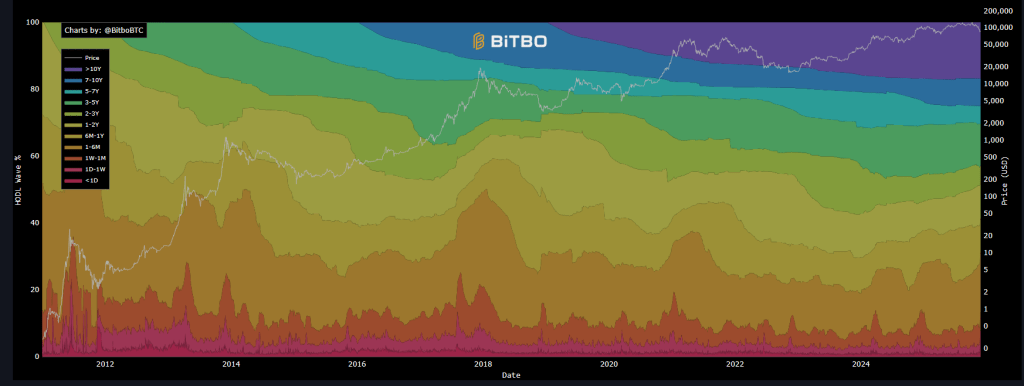
According to on-chain analyst James Check, Bitcoin could face as much a political crisis as a technological one if powerful quantum computers emerge.
He cautions that the hard part isn’t the math, but getting the Bitcoin community to agree on how to protect coins that haven’t moved for years.
Dormant Supply Risk
According to the report, approximately 32.4% of all Bitcoins have not moved in the past five years, and nearly 17% have remained untouched for more than 10 years.
The reserve contains addresses that expose public keys, making them prime targets if quantum attacks become a reality.
Some analysts estimate that approximately 6 to 7 million BTC exist in this vulnerable format. These holdings are already monitored by security experts.

HODL Waves chart for Bitcoin, based on BitBo data.
Bitcoin uses elliptic curve signatures.
Bitcoin’s current protection relies on ECDSA and Schnorr signatures. According to researchers and standards bodies, these plans could be broken by Shor’s algorithm once sufficiently large quantum computers emerge.
The US National Institute of Standards and Technology has approved several quantum-resistant signature schemes, and its Bitcoin Improvement Proposal 360 references post-quantum options. However, adoption requires broad buy-in across the network.
Allowing old coins to return to the market.
Since there is no possibility of reaching an agreement on a freeze, let’s focus on the technical aspects of quantum secure wallets and let the market solve the rest. https://t.co/7xOZRVYl5r
— _Checkmate 🟠🔑⚡☢️🛢️(@_Checkmatey_) November 23, 2025
Technical Schedule and Estimates
Today’s quantum devices have about 1,000 physical qubits. Some researchers now say a special machine with roughly 126,000 physical qubits could break the elliptic curve signature.
Others set the benchmark at around 2,300 logical qubits. This gap is important because physical and logical qubits are not the same. Changing the former to the latter requires significant error correction.
BTCUSD trading at $87,017 on the 24-hour chart: TradingView
Timelines vary, but estimates place a viable attack window in the late 2020s or early 2030s. Some scientists say the machines are unreliable and not close to practical use, and are unlikely to pose a serious threat for at least 20 to 40 years.
Companies wary of institutional measures
According to the report, some actors are already changing how they handle Bitcoin. El Salvador reportedly split its 6,284 BTC holdings between 14 addresses to lower risks.
Major companies have listed quantum issues in their filings, and stablecoin operators have raised warnings about long-term inactive wallets.
I think a lot of the confusion about quantum and BTC is that everyone frames it as a technology issue. But what makes this issue particularly unique to BTC is that the technical issues are secondary.
Quantum-resistant Bitcoin is feasible, but it doesn’t solve what older coins do.
— Ceteris (@ceterispar1bus) November 23, 2025
Politics can determine the outcome
James Check argues that the biggest risk is governance. He believes there is “no chance” the community will agree to freeze or force the transfer of coins whose owners won’t move of their own accord.
He says even if a technical fix exists, political realities could leave millions of coins exposed. Some developers and industry insiders are calling for faster action. Others believe the switch could wait until the post-quantum standard is ready.
The debate divides experts. Some argue for an early migration plan, while others say the threat is remote and manageable. Based on the report and the figures above, the picture is clear. The risks are real, the dates are uncertain, and the biggest obstacle may be human consent rather than hardware.
Featured image from PostQuantum.com, chart from TradingView

editing process for focuses on providing thoroughly researched, accurate, and unbiased content. We adhere to strict sourcing standards, and each page is diligently reviewed by our team of top technology experts and seasoned editors. This process ensures the integrity, relevance, and value of the content for readers.


